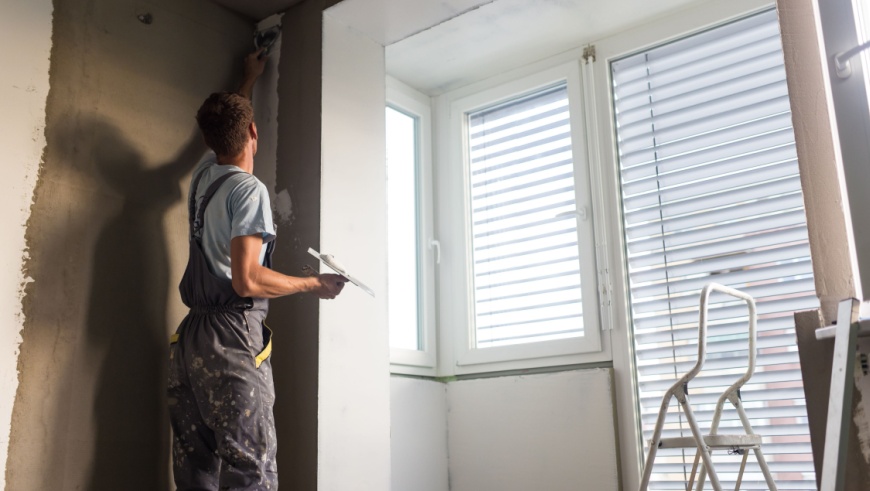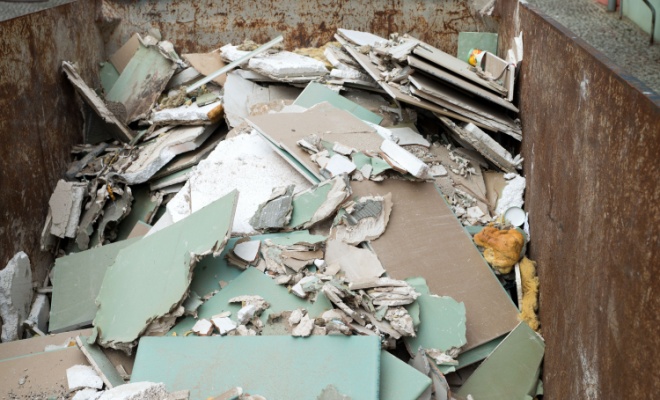Cost to Plaster a Room
Last updated 29th May, 2024
Trying to find out the cost of plastering a room or a wall?
In this price guide, we cover all costs included (on average it can range anywhere between £70 - £1400) in skimming plaster, ceiling plaster, plasterer cost, and the price of plaster.
Read on to find out more about plastering!

How Much to Plaster a Room?
The cost of plastering and skimming will vary depending on the type of the job and size of the area. For example, you should expect to pay around £70 for a small patch repair, while the cost of plastering a wall is approximately £150.
If you're planning to plaster an entire room, the cost will start from £600 for a small room and reach up to £1400 for a large room.
Plastering a ceiling typically costs more than plastering a wall, as it is a more difficult task that takes longer, and thus costs a bit more. The average cost of plastering a ceiling is around £200 to £730.
To save money, you may want to consider re-plastering, which means the old plaster does need to be stripped on. Replastering costs start from £390 for a small room and up to £700 for a larger space.
Skimming a wall is very similar to plastering a wall, except it's a smooth final layer which is added before the wall can be be painted. In terms of materials, the cost is slightly lower but the labour costs are the same, so the cost for skimming a room is normally around £150 to £200.
Table of Contents
Plastering Prices
Here are some average costs of common plastering and skimming jobs:
| Job Description | Avg. Cost |
|---|---|
| Small Patch Repair work | £70 - £130 |
| Skimming a wall | £150 - £200 |
| Plastering a wall | £150 to £200 |
| Plastering a small ceiling | £200 to £350 |
| Plastering a large ceiling | £420 - £730 |
| Re-plastering a small room | £390 to £500 |
| Re-plastering a large room | £550 to £700 |
| Plastering a small room | £600 - £700 |
| Plastering a large room | £1000 - £1400 |
Plastering Supply Costs
If you wish to tackle plastering jobs yourself, you will need to consider the following plastering supply costs:
| Material | Avg. Cost |
|---|---|
| Plasterboard | £2 - £13 per square metre |
| Plaster | £0.30 - £7 per kg |
| Plaster adhesive | £5 - £13 per bottle |
| Plasterboard screws | £2 - £13 per pack (100 screws) |
What about plastering equipment?
You will also need to consider the following plastering tools in your budget:
| Equipment | Avg. Cost |
|---|---|
| Plastering trowel | £5 - £90 |
| Plastering hawk | £9 - £30 |
| Small paintbrush | £0.40 - £12 |
| Dust sheets | £2.50 - £18 |
Additional Costs
There are some additional jobs that you may wish to consider before or after plastering, including:
Decorating
Plastering is a messy job that will require at least some decorating to finish off, so it makes perfect sense to have any painting or decorating done at this time.
Painting and decorating normally ranges from £250 to £500.
Painting Skirting Boards
You may also want to update and paint your skirting boards to finish the room of nicely.
Painting skirting boards is normally priced at £200 to £300.
Waste Disposal
If old plaster is being removed remember to budget for the cost of a skip for waste disposal, which typically costs about £140 to £300.

Cost Breakdown Calculator
Individual costs for hiring a tradesman to plaster a small room - Total Cost: £600
Materials
£300
Tradesmen
£300
Waste Removal
£0
Labour Costs and Timeframes
Now, let's take a look at labour costs and how long plastering jobs take.
Most plasterers tend to charge around £150-£200 per day for larger plastering jobs, while small repairs cost around
£20 to £40 per hour.
To help you understand plastering labour costs and timescales, take a look at the below table:
| Job Description | Labour Cost | Duration |
|---|---|---|
| Small Patch Repair work | £40 - £120 | 2-3 hours |
| Skimming a wall | £40 - £120 | 2-3 hours |
| Plastering a wall | £60 - £160 | 3-4 hours |
| Plastering a small ceiling | £120 - £320 | 6 - 8 hours |
| Plastering a large ceiling | £150 - £400 | 1 - 2 days |
| Re-plastering a small room | £150 - £400 | 1 - 2 days |
| Re-plastering a large room | £300 - £600 | 2 - 3 days |
| Plastering a small room | £300 - £600 | 2 - 3 days |
| Plastering a large room | £450 - £800 | 3 - 4 days |
What Does Plastering and Skimming Entail?
To help you understand, the process of professional plastering, here's an outline of the process:
Preparation
Before plastering, a professional will lay down dustsheets to protect flooring and any furnishings. At this point, they may even remove furniture to prevent damage.
They will then remove any dust or debris on the area that needs to be plastered and may also repair any holes or cracks they find.
If your old walls are painted, a professional will sand and clean them off before plastering.
PVA Application
Next, a PVA mixture will be brushed onto the wall. This is an important step, as it will ensure that the plaster will dry evenly.
Plaster Application
The plasterer will mix the plaster until it's ready to be applied to the wall. They will then apply the plaster on top of the PVA using a trowel and other plastering tools. They will repeat the process until the entire wall is covered.
Skimming and Smoothing
Once the first layer of plaster has been applied, the plasterer will wait for around 20 minutes for the plaster to dry. They will then use a trowel to smooth out any bumps in the plaster.
The corners and ends of the wall will also be skimmed to ensure a completely smooth finish.
Scraping
Some professional plasterers may opt to scrape the wall before adding a second coat. They will use a devilling float with nails to do this.
Second Coat Application
Once the wall has been skimmed, smoothed and scraped, the second layer of plaster can be applied. This is typically a thinner coat than the first, so it needs to be diluted further.
Finishing Touches
Once the plaster has dried completely, the walls will then be polished using water. This will be sprayed onto the edges of the plaster and the plasterer will use a trowel to smoothen out the surface.
To remove any excess plaster, sanding paper can be utilised.
DIY Plastering
Looking to save money?
If so, you may want to consider DIY plastering.
Plastering walls yourself is possible, however, it is a very messy job and some plastering methods can be quite complex.
Wet plastering is the traditional plastering method but it is a difficult technique to master for a DIY enthusiast, so you may be best hiring a professional.
A professional plasterer may be expensive but will achieve the perfect smooth flat surface an amateur could only dream of!
If you are serious about plastering you may want to think about going on a short plastering course just to pick up the basics. This will plenty of time for practice before attempting to plaster a wall in your home! The key to good plastering is to divide and tackle walls and ceilings just one section at a time and to prepare the work areas well.
Before starting the area should be clean and primed with a bonding agent if required. Screeds are needed to ensure that the plaster stays level, these wooden battens are nailed to the wall and removed after plastering.
Plastering Methods
Plastering provides a smooth, flat surface to internal walls and ceilings, ready for decorating with paint or wall paper. Plastering also adds some sound and heat insulation, and it is fire-proof too.
The type of finish you get will depend on the plastering methods you choose.
Here are some of the most common plastering methods:
Wet Plastering
Wet plastering involves the use of lime, cement or gypsum plaster mixed with sand and water. This is applied to walls when wet using a trowel.
Wet plastering is the most traditional method used by professionals. It is typically applied in small parts and can be used on small or big area.
The wet plastering method can be used on a wide range of surfaces, including plasterboard, brick, stone and concrete.
You can expect to pay around £12 to £15 per square metre for wet plastering materials.
Pros
- ✔ Provides a smooth finish
- ✔ Offers high-quality insulation
- ✔ Easy to use
Cons
- ✖ Complex application
- ✖ Expensive
Dry Plastering
Dry plastering or dry-lining is a lot easier and requires less skill, as this methods uses large flat plasterboards which are fixed to wall with adhesive.
Once the plasterboards are adhered to the wall, a finisihing coat of gypsum plaster is typically added to secure them in place.
The supply cost of dry plastering is typically around £12 to £16 per square metre.
Pros
- ✔ Avoids hairline cracks
- ✔ Reduced drying time
- ✔ Cheaper option
Cons
- ✖ Not ideal for small spaces
- ✖ Not as insulating
Plaster Removal Cost
Want a smoother finish?
For a blemish-free look, you may want to consider removing the old plaster from your walls before adding new plaster, paint or wallpaper.
You may also want to remove plaster if you plan to install drywall.
To ensure, the old plaster is removed correctly, you may want to hire a qualified plaster, who will charge a daily rate of around £150 to £250 or £20 to £40 per hour for smaller jobs.
If you want to save money you can remove it yourself, however it is a messy and time-consuming job.
The plaster removal process involves hammering through the plaster in order to remove it from the wall. You need to be very careful when doing this to avoid any damage to the wall or interference with wiring or pipes.
FAQs
The plaster needs to bind to the wall itself, not a layer of paper covering the wall. Even though wood chip is pretty strong for wallpaper, it's not strong enough to hold the additional weight of a skim coat of plaster. So all the wallpaper needs to be removed to ensure proper adhesion of the new plaster skim.
This means some serious work if you have wood chip, or be prepared to pay a decent sum for a tradesperson to remove it for you!
How To Find and Hire a Plasterer
Before hiring a professional plasterer, get a least three quotes from different plasterers to ensure you are getting a fair price for the job.
Make sure you check out job reviews, as this will offer you reassurance that the plasterer you hire is republe and reliable.
You can ask for qualifications if necessary, although to become a plasterer you do not need any official qualifications.
Also, double check that they have the correct insurance, as this will cover both you and them in the event of an accident or damage.
Sources
https://www.diy.com/departments/building-supplies/plastering-supplies/plasterboard/DIY570176.cat?sort=product.price
https://www.wickes.co.uk/how-to-guides/decorating/plaster-a-wall








